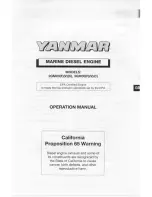
30
COMPILER TECO/ATI
ENDORSED
DATE
23.06.2003
REG. CODE
1-5302-607
MODEL N°
50889
DATE OF ISSUE
06-03
REVISION
00
XII
51
52
53
54
50
ELECTRICAL EQUIPMENT
Cables color (fig. 50-51)
M
Brown
N
Black
A
White
V
Green
R
Red
Description (fig. 50-51)
1. Ignition key (optional)
2. Voltage regulator
3. Engine starter
4. Battery (not included)
5. Alternator
6. Pressure switch
7. Battery recharge warning light (optional)
8. Oil pressure warning light (optional)
Checking electrical equipment
1. Make sure that the connections between the voltage regulator
and alternator are correctly made and in good condition.
2. Disconnect the starter motor wire from the battery terminal and
connect a dc ammeter (fig.50 and 51).
3. Connect a dc voltmeter to the battery terminals (fig.50 and 51).
4. Turn over the engine a few times without load or connect an
80÷100W lamp load across the battery to restrict voltage to
lower than 13V.
5. Accelerate the engine to 3000 rpm. The current shown by the
ammeter must be in line with the values indicated in figure 52.
6. Disconnect the load from the battery (if it was previously
connected) and keep the engine running at the above indicated
speed for a few minutes, the battery voltage should slowly
increase until it reaches approximately 14.2V. At the same time
the charge current should drop to around 2A in a period of time
that depends on the whether the battery is fully charged or not.
7. If the charging current is absent or is lower than the value
indicated above, proceed by checking the alternator and if
necessary, renewing the voltage regulator.
Checking the alternator
Check:
1. with motor stopped: the continuity of the windings (fig.53) by
connecting an ohmmeter and ensuring that resistance is zero,
and the insulation between the windings and ground (fig. 54) by
ensuring that the ohmmeter gives a reading of infinite
resistance. If these readings are not obtained the stator must
be renewed.
2. with motor running: use a multitester to check the charge
current between the two yellow wires. Bring the engine up to
3000 rpm - the multitester should give a reading of 35V.
If the values are more than 10V below this value, the rotor is de-
magnetized and the alternator must be renewed.
Important:
1. The alternator will not deliver current when the yellow wires are
disconnected.
2. The alternator will burn out if the yellow wires are connected to
ground.
3. The voltage regulator may be damaged if the ground
connection or other circuit connections are not made properly.
4. The alternator and the voltage regulator will burn out instantly if
the battery connections are inverted.
Internal built-in alternator
External alternator
cables: Color
x Section (mm²)
cables: Color
x Section (mm²)
Plant specifications
Starter motor:
Left rotation, 12V, power from 1.25 to 1.4 kW
Built-in alternator:
280W
Voltage regulator:
Electronic with controlled diodes and connection
for battery charge indicator light
External alternator:
12V - 400W
Recommended battery:
Refer to tables in chapters 4
Flywheel ring gear:
Check teeth for wear or damage. Fit crown
wheel to flywheel by pre-heating to 200-250°C.















































